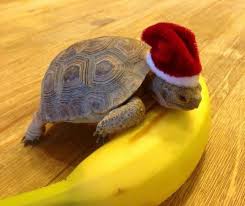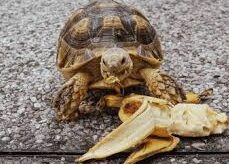Can Turtles Eat Banana
I’ve often noticed that people assume every species of turtle will happily chew on any fruit, but in reality their diet is far more nuanced. Some semi-aquatic turtles raised as pets might accept bananas as an occasional treat, yet the balance of nutrition in their feeding schedule still depends on vegetation, worms, or even shrimp. Having cared for both juveniles and adults, I realized that too much plant material from sugary fruits can disturb the natural ratio of portions, affecting overall health. Even though turtles in the wild nibble on different greens or insects, giving them human-style foods with refined sugars is something to avoid, as can turtles eat banana it’s not part of their evolutionary requirements.

What Fruits Do Turtles Eat? / Can Turtles Eat Banana
New turtle keepers often ask, is banana safe for turtles? The short answer is yes, but only in moderation.
In practice, I’ve seen box turtles in my own aquarium eagerly testing bananas. A few even tried to break pieces and let them float in the tank. This shows they may actually love such flavors, but only when offered in tiny portions.
Fruits like citrus, avocados, or even nuts are considered unsafe. A vet will always give advice to stick with balanced guidelines instead of experimenting too much.
I usually remove uneaten bits the same day because excess sugars can create a messy environment and attract insects.
When I consult with experienced parents of turtle keepers, they also emphasize the need for calcium and vitamin supplements instead of relying heavily on fruit.
My perspective is clear: let turtles have their natural variety, but treat fruits as a light add-on, not as a staple of their feeding schedule.
What Can Turtles Not Eat? / Foods to Avoid
Through my own experience of keeping turtles, I have learned that not every fruit or vegetables offered with good intentions actually supports their diet. Items like canned or pickled foods often contain refined sugars and oil that disrupt a turtle’s natural balance. A friend once handed his pet a slice of cantaloupe with the rind still attached, and I noticed how the beak struggled with shredding, creating a choking risk. This is why I always trim and carefully offer only safe, raw pieces in light amounts. Even though some of their favorites include melon, berries, or a banana, moderation is key—anything excessive can lead to weight issues for these delicate domesticated animals.
On the other hand, certain human items like grapes, oranges, apple, or pears should only be given on an occasional basis, since overfeeding may cause digestion troubles. I personally avoid serving them sugary snacks, because unlike us, turtles cannot enjoy processed options without harm. Observing them in the wild, they stick to a more natural pattern of eating, free of artificial preservatives. Keeping their meals close to what they would find in animals and plants outside ensures healthier swallowing, steadier energy, and less dependence on unsuitable human food. Over time, this careful avoidance of inappropriate snacks has helped my turtles maintain smooth feeding habits while minimizing long-term risks.
How Much to Feed a Turtle
When I first experimented on can turtles eat banana with adjusting the feed schedule for my turtles, I noticed how easily too many items like frozen or freeze-dried treats could disrupt their balance.
A turtle’s body, unlike ours, responds quickly to excess oils, fried foods, or even dairy. These ingredients can leave them sluggish and deficient in essential vitamins despite appearing full.
The trick is not about volume but about mindful observation—placing meals in a dedicated place where I could measure exactly how much was consumed without waste or hidden scraps.
Through this practice, I realized that offering small portions with a variety of safe foods avoids the risk of them nibbling on harmful chocolate or processed meat, which should absolutely never be included.
Over time, I found that feeding turtles the right way is less about strict rules and more about understanding their cues as semi-aquatic reptiles. My own red-eared slider once taught me that skipping an extra snack was healthier than overloading him with extra pellet mixes or excessive live food. Moderation helps keep their omnivorous or carnivorous instincts satisfied while allowing natural digestion to work properly. For me, maintaining balance means offering measured meals that support growth without burdening their system, just enough, not too much.

How Much to Feed a Turtle
From my own practice, I’ve learned that controlling the amount is just as important as choosing the right food. Many omnivorous turtles tend to overeat if given constant access, which leads to sluggish behavior and poor shell development. A balanced diet, whether it includes leafy greens or occasional protein, should always be measured rather than piled into the tank. Careful observation over weeks helps determine what’s truly enough for their growth without excess waste.
When discussing what turtles consume, I often explain to new keepers that their meals can include both algae and properly formulated commercial mixes. While some species may crave more protein, others lean toward vegetation, so it’s about offering choice within safe limits. These prepared options often provide the baseline nutrients, and then you can add occasional fresh items to keep the diet varied.
As for timing, a schedule of feeding every 2-3 days has proven healthier for adults than daily offerings. Can turtles eat banana this more regular pattern helps simulate how turtles forage in nature, preventing obesity while maintaining energy. Hatchlings may require slightly more frequent meals, but even then, the emphasis should remain on moderation and consistency rather than constant snacking.
Supplements are not always mandatory, yet certain vitamins and minerals are truly essential when natural sunlight or food diversity is lacking. For instance, calcium and vitamin D3 often need attention. My experience has shown that occasional supplementation can close nutritional gaps, especially in indoor setups. Likewise, different species such as box turtles come with their own challenges; their care must account for specific dietary needs, blending vegetables, insects, and safe fruits in smaller controlled portions. Even the popular red-eared slider, one of the most common pets, requires thoughtful care to balance between aquatic pellets, greens, and safe protein choices.
FAQs
Q: Can turtles eat banana safely?
A: Yes, turtles can eat banana, but only in small portions. Bananas are high in sugar, which can cause digestive issues if fed regularly. Think of it as an occasional treat, not a staple food as you got Turtles Eat Bananas.
Q: How often should I give banana to my turtle?
A: Offering banana once every couple of weeks is more than enough. Feeding too much or too often can lead to obesity, shell deformities, or nutritional imbalances.
Q: Are bananas good for all turtle species?
A: Not necessarily. While many pet turtles may enjoy them, some species—especially strictly carnivorous turtles—should avoid fruits like bananas altogether. Always research your turtle’s species before adding fruit.
Q: Can baby turtles eat banana?
A: Baby turtles need more protein for growth, so bananas should be avoided in their early stages. A protein-rich diet with occasional leafy greens is better suited for hatchlings.
Q: Do red-eared sliders eat banana?
A: Red-eared sliders can nibble on small banana pieces, but it should remain a rare treat. Their diet should focus more on pellets, aquatic plants, and insects.
Q: Can bananas replace vegetables in a turtle’s diet?
A: No, bananas cannot replace vegetables. Leafy greens and aquatic plants provide the vitamins, minerals, and fiber turtles need, while bananas are high in sugar and low in essential nutrients.
Q: What fruits are safer for turtles than bananas?
A: Fruits like apples (without seeds), berries, melons, and mango can be offered occasionally in moderation. Always wash them thoroughly and cut into small pieces.
Q: What foods should turtles never eat?
A: Avoid chocolate, processed meat, fried foods, dairy, onions, and foods high in salt or fat. These items are harmful and can cause long-term health issues as turtles eat bananas.
Q: How do I know if my turtle is eating too much fruit?
A: Signs include watery stool, weight gain, reduced activity, and refusal of staple foods. If you notice these, cut back on fruit immediately and return to a balanced diet.
Q: What’s the healthiest feeding routine for turtles?
A: Offer a mix of pellets, leafy greens, aquatic plants, and live protein, depending on the species. Fruits like bananas should make up less than 10% of the overall diet as turtles eat bananas quickly.
Pingback: Best Food for Baby Red-Eared Slider Turtles: 7 Complete Diet & Care Guides